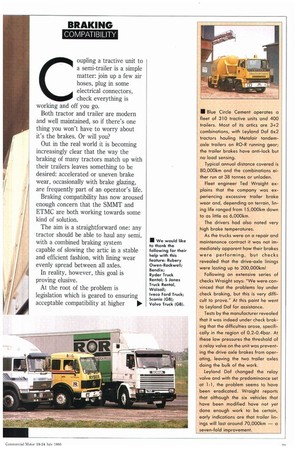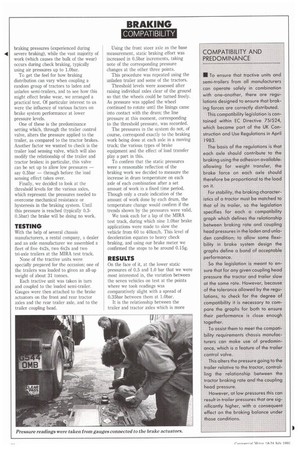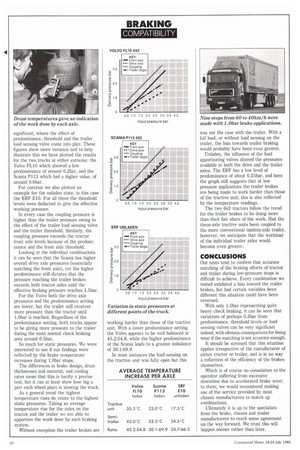C oupling a tractive unit to a semi-trailer is a simple
Page 31

Page 32

Page 34

If you've noticed an error in this article please click here to report it so we can fix it.
matter: join up a few air hoses, plug in some electrical connectors, check everything is working and off you go.
Both tractor and trailer are modern and well maintained, so if there's one thing you won't have to worry about it's the brakes. Or will you?
Out in the real world it is becoming increasingly clear that the way the braking of many tractors match up with their trailers leaves something to be desired: accelerated or uneven brake wear, occasionally with brake glazing, are frequently part of an operator's life.
Braking compatibility has now aroused enough concern that the SMMT and ETMC are both working towards some kind of solution.
The aim is a straightforward one: any tractor should be able to haul any semi, with a combined braking system capable of slowing the artic in a stable and efficient fashion, with lining wear evenly spread between all axles.
In reality, however, this goal is proving elusive.
At the root of the problem is legislation which is geared to ensuring acceptable compatibility at higher
braking pressures (experienced during severe braking), while the vast majority of work (which causes the bulk of the wear) occurs during check braking, typically using air pressures up to 1.0bar.
To get the feel for how braking distribution can vary when coupling a random group of tractors to laden and unladen semi-trailers, and to see how this might effect brake wear, we arranged a practical test. Of particular interest to us were the influence of various factors on brake system performance at lower pressure levels.
One of these is the predominance setting which, through the trailer control valve, alters the pressure applied to the trailer, as compared to the tractor brakes. Another factor we wanted to check is the trailer load sensing valve, which will also modify the relationship of the trailer and tractor brakes: in particular, this valve can be set up to allow low pressures — say 0.5bar — through before the load sensing effect takes over.
Finally, we decided to look at the threshold levels for the various axles, which represent the pressures needed to overcome mechanical resistance or hysteresis in the braking system. Until this pressure is reached (typically 0.30.5bar) the brake will be doing no work.
TESTING
With the help of several chassis manufacturers, a rental company, a dealer and an axle manufacturer we assembled a fleet of five 4x2s, two 6x2s and two tri-axle trailers at the MIRA test track.
None of the tractive units were specially prepared for the occasion; one of the trailers was loaded to given an all-up weight of about 31 tonnes.
Each tractive unit was taken in turn and coupled to the loaded semi-trailer. Gauges were then attached to the brake actuators on the front and rear tractor axles and the rear trailer axle, and to the trailer coupling head. Using the front steer axle as the base measurement, static braking effort was increased in 0.5bar increments, taking note of the corresponding pressure changes at the other three points.
This procedure was repeated using the unladen trailer and some of the tractors.
Threshold levels were assessed after raising individual axles clear of the ground so that the wheels could be turned freely. As pressure was applied the wheel continued to rotate until the linings came into contact with the drum; the line pressure at this moment, corresponding to the threshold pressure, was recorded.
The pressures in the system do not, of course, correspond exactly to the braking work being done at each axle in a moving truck; the various types of brake equipment and the effect of load transfer play a part in this.
To confirm that the static pressures were a reasonable reflection of the braking work we decided to measure the increase in drum temperature on each axle of each combination after a set amount of work in a fixed time period. Though only a crude indication of the amount of work done by each drum, the temperature change would confirm if the trends shown by the pressures were valid.
We took each for a lap of the MIRA test track, during which nine 1.0bar brake applications were made to slow the vehicle from 60 to 40km/h. This level of deceleration equates to heavy check braking, and using our brake meter we confirmed the stops to be around 0.15g.
RESULTS
On the face of it, at the lower static pressures of 0.5 and 1.0 bar that we were most interested in, the variation between the seven vehicles on test at the points where we took readings was comparatively slight with a spread of 0.35bar between them at 1.0bar.
It is the relationship between the trailer and tractor axles which is more significant, where the effect of predominance, threshold and the trailer load sensing valve come into play. These figures show more variance and to help illustrate this we have plotted the results for the two trucks at either extreme: the Volvo FL10 which showed a low predominance of around 0.2bar, and the Scania P113 which had a higher value, of around 0.6bar.
For contrast we also plotted an example for the unladen state, in this case the ERF E10. For all three the threshold levels were deducted to give the effective working pressure.
In every case the coupling pressure is higher than the trailer pressure owing to the effect of the trailer load sensing valve and the trailer threshold. Similarly, the coupling pressure exceeds the tractor front axle levels because of the predominance and the front axle threshold.
Looking at the individual combinations it can be seen that the Scania has higher overall drive axle pressures (essentially matching the front axle), yet the higher predominance still dictates that the pressure reaching the trailer brakes exceeds both tractor axles until the effective braking pressure reaches 1.5bar.
For the Volvo both the drive axle pressures and the predominance setting are lower, but the trailer still receives more pressure than the tractor until 1.0bar is reached. Regardless of the predominance setting, both trucks appear to be giving more pressure to the trailer during the most normal check braking area around 0.5bar.
So much for static pressures. We were interested to see if our findings were reflected by the brake temperature increases during 1.0bar stops.
The differences in brake design, drum thicknesses and material, and cooling rates mean that this is hardly a precise test, but it can at least show how big a part each wheel plays in slowing the truck.
As a general trend the highest temperature rises do relate to the highest static pressures. Taking an average temperature rise for the axles on the tractor and the trailer we are able to apportion the work done by each braking system.
Without exception the trailer brakes are working harder than those of the tractive unit. With a lower predominance setting the Volvo appears to be well balanced at 45.2:54.8, while the higher predominance of the Scania leads to a greater imbalance of 30.1:69.9.
In most instances the load sensing on the tractive unit was fully open but this was not the case with the trailer. With a full load, or without load sensing on the trailer, the bias towards trailer braking would probably have been even greater.
Unladen, the influence of the load apportioning valves altered the pressures available at both the drive and the trailer axles. The ERF has a low level of predominance of about 0.25bar, and here the graph still suggests that at low pressure applications the trailer brakes are being made to work harder than those of the tractive unit; this is also reflected by the temperature readings.
The two 6x2 tractors follow the trend for the trailer brakes to be doing more than their fair share of the work. Had the three-axle tractive units been coupled to the more conventional tandem-axle trailer, however, we anticipate that the workload of the individual trailer axles would become even greater.
CONCLUSIONS
Our tests tend to confirm that accurate matching of the braking efforts of tractor and trailer during low-pressure stops is difficult to achieve. Every combination we tested exhibited a bias toward the trailer brakes, but had certain variables been different this situation could have been reversed.
With only 1.0bar representing quite heavy check braking, it can be seen that variations of perhaps 0.5bar from predominance, threshold levels or load sensing valves can be very significant indeed, with obvious consequences for lining wear if the matching is not accurate enough.
It should be stressed that this situation applies irrespective of the manufacturer of either tractor or trailer, and is in no way a reflection of the efficiency of the brakes themselves.
Which is of course no consolation to the operator suffering from excessive downtime due to accelerated brake wear; to them, we would recommend making use of the service provided by most chassis manufacturers to match up combinations.
Ultimately it is up to the specialists from the brake, chassis and trailer manufacturers to reach some agreement on the way forward. We trust this will happen sooner rather than later.












































































































